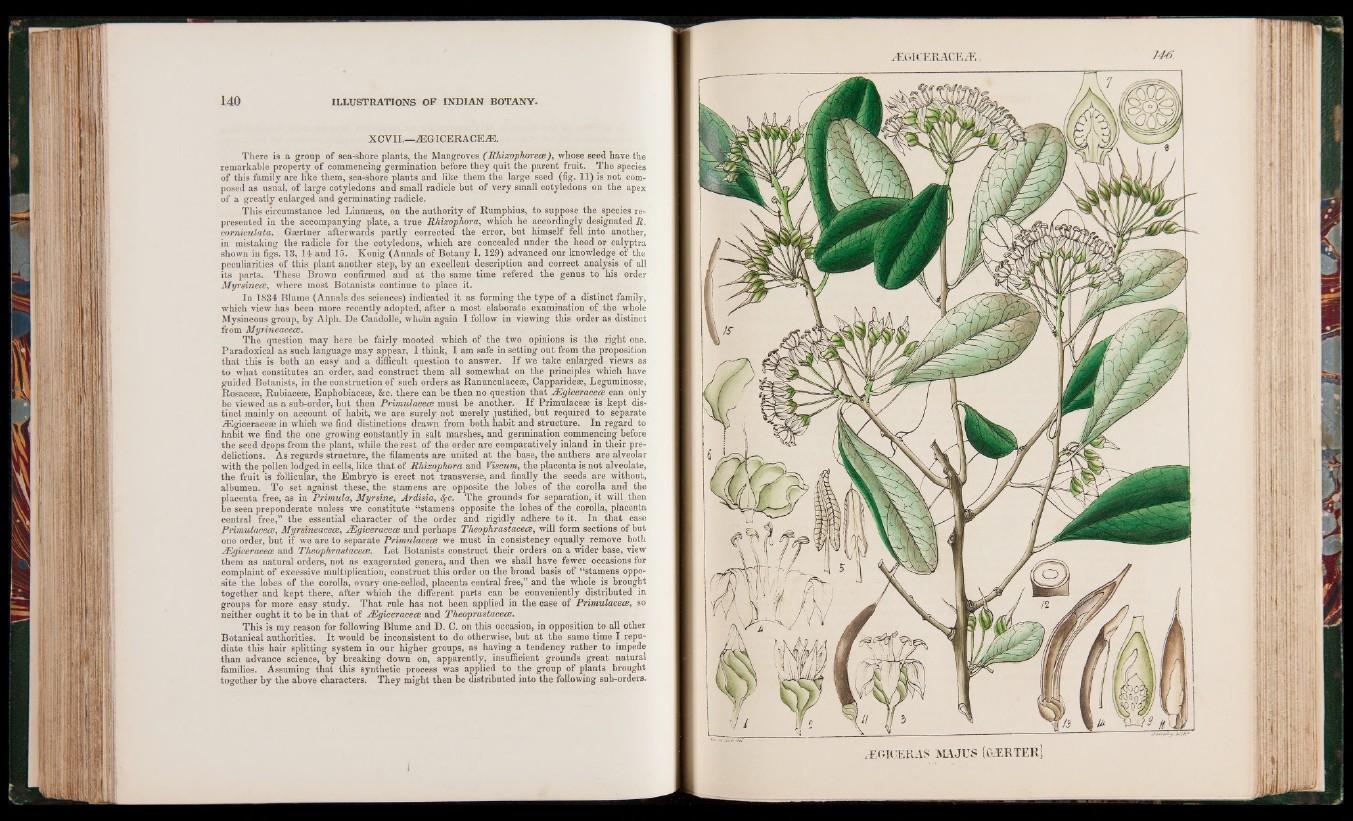
XCVII.—ASGICERACEiE.
There is a group of sea-shore plants, the Mangroves ( Rhizophorece), whose seed have the
remarkable property of commencing germination before they quit the parent fruit. The species
of this family are like them, sea-shore plants and like them the large seed (fig. 11) is not composed
as usual, of large cotyledons and small radicle but of very small cotyledons on the apex
of a greatly enlarged and germinating radicle.
This circumstance led Linnaeus, on the authority of Rumphius, to suppose the species represented
in the accompanying plate, a true Rhizophora, which he accordingly designated R.
corniculata. Gaertner afterwards partly corrected the error, but himself fell into another,
in mistaking the radicle for the cotyledons, which are concealed under the hood or calyptra
shown in figs. 13, 14 and 15. Konig (Annals of Botany E 129) advanced our knowledge of the
peculiarities of this plant another step, by an excellent description and correct analysis of all
its parts. These Brown confirmed and at the same time refered the genus to his order
Myrsinece, where most Botanists continue to place it.
In 1834 Blume (Annals des sciences) indicated it as forming the type of a distinct family,
which view has been more recently adopted, after a most elaborate examination of the whole
Mysineous group, by Alph. De Candolle, whom again I follow in viewing this order as distinct
from Myrineacece.
The question may here be fairly mooted which of the two opinions is the right one.
Paradoxical as such language may appear, I think, I am safe in setting out from the proposition
that this is both an easy and a difficult question to answer. If we take enlarged views as
to what constitutes an order, and construct them all somewhat on the principles which have
guided Botanists, in the construction of such orders as Ranunculaceae, Capparideae, Leguminosae,
Rosaceae, Rubiaceae, Euphobiaceae, &c. there can be then no question that JEgiceracece can only
be viewed as a sub-order, but then Primulacece must be another. If Primulaceas is kept distinct
mainly on account of habit, we are surely not merely justified, but required to separate
.ZEgiceraceae in which we find distinctions drawn from both habit and structure. In regard to
habit we find the one growing constantly in salt marshes, and germination commencing before
the seed drops from the plant, while the rest of the order are comparatively inland in their pre-
delictions. As regards structure, the filaments are united at the base, the anthers are alveolar
with the pollen lodged in cells, like that of Rhizophora and Viscum, the placenta is not alveolate,
the fruit is follicular, the Embryo is erect not transverse, and finally the seeds are without,
albumen. To set against these, the stamens are opposite the lobes of the corolla and the
placenta free, as in Primula, Myrsine, Ardisia, fyc. The grounds for separation, it will then
be seen preponderate unless we constitute “stamens opposite the lobes of the corolla, placenta
central free,” the essential character of the order and rigidly adhere to it. In that case
Primulacece, Myrsineacece, JEgiceracece and perhaps Theophrastacece, will form sections of but
one order, but if we are to separate Primulacece we must in consistency equally remove both
JEgiceracece and Theophrastacece. Let Botanists construct their orders on a wider base, view
them as natural orders, not as exagerated genera, and then we shall have fewer occasions for
complaint of excessive multiplication, construct this order on the broad basis of “stamens opposite
the lobes of the corolla, ovary one-celled, placenta central free,” and the whole is brought
together and kept there, after which the different parts can be conveniently distributed in
groups for more easy study. That rule has not been applied in the case of Primulacece, so
neither ought it to be in that of JEgiceracece and Theoprastacece.
This is my reason for following Blume and D. C. on this occasion, in opposition to all other
Botanical authorities. I t would be inconsistent to do otherwise, but at the same time I repudiate
this hair splitting system in our higher groups, as having a tendency rather to impede
than advance science, by breaking down on, apparently, insufficient grounds great natural
families. Assuming that this synthetic process was applied to the group of plants brought
together by the above characters. They might then be distributed into the following sub-orders.
ÆGICERACEÆ. J46.
ÆGICERAS MA JUS GÆRTER